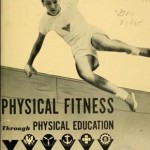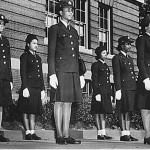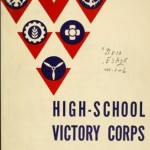High School Victory Corps Established
On September 25, 1942, upon the recommendation of the U.S. War Manpower Commission, Commissioner of Education John W. Studebaker announced the launch of a nationwide initiative ‘designed to mobilize secondary school students for more effective preparation and participation in wartime service.’ This voluntary organization, aimed at the country’s more-than-six-million students attending some of its over-28,000 high schools, was called the High School Victory Corps and was conceived to prepare young Americans for service ‘in the armed forces tomorrow through learning in the classroom today.’
More than a patriotic or extracurricular service group, the High School Victory Corps program emphasized an entirely supplemental war-time education, complete with its own uniform, insignia, physical fitness regimen and command structure. In order to participate in the High School Victory Corps, students – both male and female – were required to enroll in a war-effort class (such as first-aid, marksmanship or navigation), pass a physical fitness inspection and volunteer in at least one extracurricular wartime activity. For their uniform, Victory Corps members were issued service caps embroidered with the Corps insignia and service patches indicating the focus of their wartime course work. Physical fitness, through sports and military drill, was considered a special focus of the program as draft officials at the time were alarmed by the growing number of recent enlistments declared unfit. National leadership of the High School Victory Corps was entrusted to its National Policy Committee headed by Captain “Fast” Eddie Rickenbacker, a WWI fighter ace and Medal of Honor recipient.
The High School Victory Corps program proved extremely popular during the two years of its existence, with a wealth of pamphlets and instructional policy guide books being produced and issued to schools and teachers. The High School Victory Corps program was also groundbreaking for its time by allowing participation from both white and African-American students a full decade before public school desegregation.
Today, The National WWII Museum honors the contributions made by the High School Victory Corps through its Victory Corps young volunteer program, which takes the wartime program as its namesake and seeks to continue its seventy-year-old mission of service and education with the students of today’s generation.
Post by Collin Makamson, Red Ball Express Coordinator at The National WWII Museum
- Posted :
- Post Category :
- Tags : Tags: Home Front, Victory Corps
- Follow responses to this entry through the RSS 2.0 feed. You can skip to the end and leave a response. Pinging is currently not allowed.








Leave a Reply